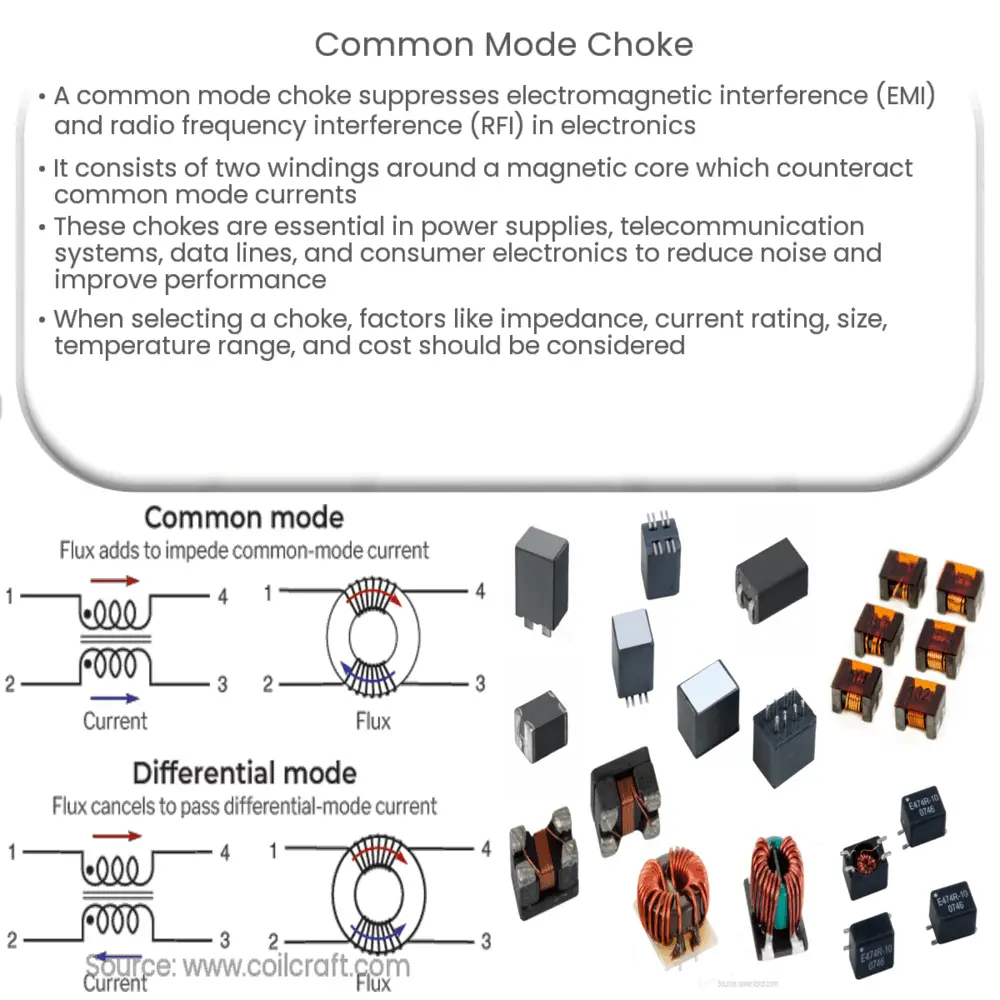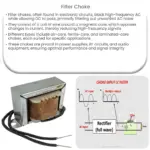A common mode choke is an essential electronic component that suppresses electromagnetic interference (EMI) and radio frequency interference (RFI), improving device performance and reliability.

Common Mode Choke: An Introduction
A common mode choke, also known as a common mode inductor or common mode filter, is an essential component used in electronics to suppress electromagnetic interference (EMI) and radio frequency interference (RFI). These unwanted signals can cause performance issues in electronic devices, making common mode chokes a crucial part of many electrical systems. In this article, we will explore the fundamental principles, applications, and advantages of common mode chokes.
How Common Mode Chokes Work
At its core, a common mode choke is an inductive component that consists of two windings around a magnetic core. These windings are tightly coupled, which means that any current passing through one winding will induce an equal and opposite current in the other. This property is key to understanding how common mode chokes function in suppressing EMI and RFI.
In an electrical circuit, there are two types of currents: differential mode and common mode. Differential mode currents are the intended signals that flow through the circuit in opposite directions, while common mode currents are undesirable noise signals that flow in the same direction on both conductors. Common mode chokes are designed to specifically target and suppress common mode currents without affecting differential mode currents.
When common mode currents pass through the windings of a common mode choke, they generate an equal and opposite magnetic field in the magnetic core. These magnetic fields effectively cancel each other out, resulting in a significant reduction in common mode currents. Meanwhile, differential mode currents, which flow in opposite directions, produce magnetic fields that reinforce each other, allowing them to pass through the choke unaffected.
Applications of Common Mode Chokes
Common mode chokes can be found in a wide range of applications, including:
- Power supplies: In power supply circuits, common mode chokes can reduce noise and improve the overall performance and efficiency of the system.
- Telecommunication systems: In communication systems, common mode chokes help to eliminate noise and maintain signal integrity, ensuring clear and reliable communication.
- Data lines: Common mode chokes are used in data transmission lines to suppress noise and improve data transfer rates and signal quality.
- Consumer electronics: In devices such as computers, smartphones, and televisions, common mode chokes play a crucial role in reducing EMI and RFI, which can degrade performance and cause interference with other devices.
By suppressing EMI and RFI, common mode chokes enhance the performance and reliability of electronic devices, making them an indispensable component in modern electronics.
Selection Criteria for Common Mode Chokes
When selecting a common mode choke for a specific application, there are several factors to consider:
- Impedance: The impedance of the choke should be high enough to effectively suppress common mode noise at the desired frequency range.
- Current rating: The choke should have a current rating that can handle the maximum current of the application without overheating or saturating the magnetic core.
- Size and form factor: The physical size and shape of the choke should fit within the constraints of the design, considering factors such as available space, weight, and mounting requirements.
- Temperature range: The choke should operate within the expected temperature range of the application, ensuring that it maintains its performance under varying environmental conditions.
- Cost: The cost of the common mode choke should be balanced against the benefits it provides in terms of performance improvement and compliance with regulatory requirements.
By carefully considering these factors, engineers can select the most suitable common mode choke for their application, ensuring optimal performance and reliability.
Advantages of Common Mode Chokes
Common mode chokes offer several advantages in electronic systems, including:
- Enhanced performance: By suppressing EMI and RFI, common mode chokes improve signal integrity and reduce the likelihood of system failures and performance issues.
- Regulatory compliance: Many electronic devices are subject to regulatory standards that limit the amount of EMI and RFI they can emit. By incorporating common mode chokes, manufacturers can more easily meet these requirements and avoid potential fines or product recalls.
- Improved efficiency: Reducing EMI and RFI can lead to more efficient power conversion and reduced energy consumption, resulting in lower operating costs and a smaller environmental footprint.
- Compact design: Modern common mode chokes are available in compact and lightweight designs, making them suitable for use in a wide range of applications, including space-constrained consumer electronics.
Conclusion
Common mode chokes play a vital role in suppressing EMI and RFI, improving the performance and reliability of electronic devices. With a wide range of applications, from power supplies and telecommunication systems to consumer electronics, these essential components are an integral part of modern electronics. By understanding their principles, applications, and advantages, engineers can make informed decisions when selecting and implementing common mode chokes in their designs.



